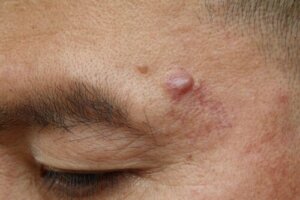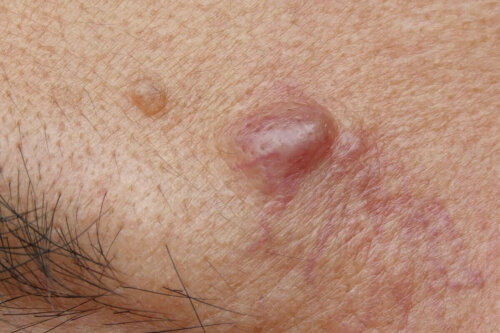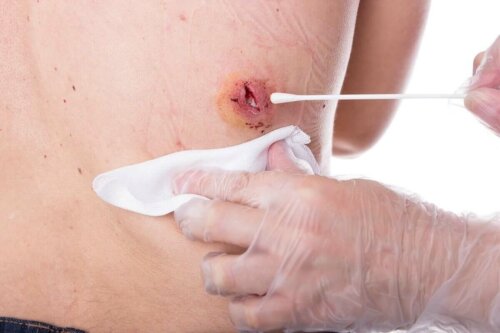Causes and Possible Treatments for Epidermoid Cysts


Written and verified by the dermatologist Maria del Carmen Hernandez
Epidermoid cysts are small, benign lumps on the skin. Their location varies but they appear on the face, neck, and trunk mainly.
These types of cysts grow slowly and are rarely painful. There’s rarely discomfort and this is why they don’t require treatment. Continue reading to find out the main causes and available treatments for these unsightly skin blemishes.
What causes epidermoid cysts?
The epidermis, the most superficial layer of the skin, is made up of a thin surface that protects cells that are constantly changing. In most cases, epidermoid cysts develop when cells in the epidermis don’t shed properly and continue to multiply instead.
They might even be located deeper within the skin. Another cause of their appearance is a skin lesion or irritation of the most superficial portion of a hair follicle.
The walls of this kind of cyst are formed by the cells of the epidermis, and keratin then secretes into the cyst. Thus, any damage to a hair follicle or sebaceous gland in the skin can trigger abnormal epidermal cell growth.
Symptoms of epidermoid cysts
Epidermoid cysts don’t manifest with too many symptoms, but they do have some characteristics such as:
- A visible small, round-shaped lump under the skin of the face, neck, or trunk
- The central opening of the cyst is blocked by a black pimple
- The area of the skin may be reddened if the cyst is infected or inflamed and there’s increased sensitivity and inflammation
- There may be a thick, yellow, smelly fluid draining out of it

Must you consult a doctor?
Most epidermoid cysts don’t lead to further health problems and don’t require treatment. Do seek prompt attention if you observe the following characteristics:
- Fast growth
- There’s rupture and it leads to pain or other signs of infection
- The epidermoid cyst settles in an area that’s always irritated
- It causes discomfort due to aesthetic reasons
- It’s located in an unusual part of your body, such as the fingers
- Finally, if it leads to fever
Read also Tips to Prevent Skin Diseases
Risk factors for epidermoid cysts
Anyone can develop one or more epidermoid cysts, but puberty can influence their appearance. Men are more predisposed to having them, as do those with Gardner syndrome, basal cell nevus syndrome, or pachyonychia congenita type II.
Possible complications
There are complications on rare occasions, among them:
- Inflammation
- Painful infection and abscesses
- The rupture caused by trauma or by a bacterial infection caused by Staphylococcus aureus, Escherichia coli, and group A Streptococcus
- Skin cancer (a study reveals that 1% of cysts undergo a malignant transformation towards basal cell carcinoma or squamous cell carcinoma)
Diagnosis
Doctors should be able to diagnose simply by evaluating the cyst. It looks similar to a sebaceous one, but they’re not due to the same pathology. The cause of epidermoid cysts is damage to the hair follicles or the outermost layer of the skin. Thus, a doctor will request a biopsy to rule out other conditions if they don’t trust their diagnosis.
Differential diagnosis
- Dermoid cysts
- Lipomas
- Pseudocysts of acne
- Myxoid pseudocysts
You may be interested in Reactive Skin: Symptoms, Causes, and Treatment
Treatment of epidermoid cysts
Epidermoid cysts don’t usually require treatment, only those that cause discomfort due to the location, for aesthetic reasons, or because they cause repeated infections. Continue reading to find out what are the main therapeutic options.
Incision and drainage
This treatment consists of making a cut in the epidermoid cyst. Then, they’ll exert slight manual pressure in order to squeeze out the fluid. This procedure is quick and easy, but the cyst might recur over time if the practitioner doesn’t do it right.
They must know it’s necessary to extract the content of the tumor and, in turn, the capsule that contains it. Otherwise, the cyst will re-form over time.

Minor surgery
This treatment requires a specialist who can remove the entire cyst, including its inner capsule. A study published in the Medical Sciences journal details the importance of excising the entire lining of this tumor in order to reduce the rates of recurrence.
A patient who undergoes this procedure will likely have to return a few days later to have the stitches removed. This surgery is minor, but it prevents regrowth in the same area. However, in those cases in which there’s inflammation or infection, a practitioner will have to carry out the corresponding treatment and then schedule surgery.
Infiltration
Another treatment consists of injecting a corticosteroid medication into the cyst area if there’s swelling or inflammation. Only a professional can determine this, however.
Antibiotic therapy
There are times in which the presence of an infection is evident. Thus, a doctor will recommend an oral antibiotic treatment as the first instance. They’ll evaluate other therapeutic options once the infection subsides.
A tumor isn’t necessarily malignant
Epidermoid cysts are benign skin tumors. In fact, they’re very common and don’t require medical treatment as long as there are no bad symptoms. Try not to pick them off in order to avoid infection or further complications.
We hope you’ve enjoyed this article.
https://mejorconsalud.com/quistes-epidermoides-causas-tratamientos/
All cited sources were thoroughly reviewed by our team to ensure their quality, reliability, currency, and validity. The bibliography of this article was considered reliable and of academic or scientific accuracy.
- Zito PM, Scharf R. Cyst, Epidermoid (Sebaceous Cyst) [Updated 2020 Apr 29]. In: StatPearls [Internet]. Treasure Island (FL): StatPearls Publishing; 2020 Jan-. Available from: https://www.ncbi.nlm.nih.gov/books/NBK499974/
- Habif TP. Benign skin tumors. In: Habif TP, ed. Clinical Dermatology: A Color Guide to Diagnosis and Therapy. 6th ed. Philadelphia, PA: Elsevier; 2016
- Weir CB, St.Hilaire NJ. Epidermal Inclusion Cyst. [Updated 2020 May 3]. In: StatPearls [Internet]. Treasure Island (FL): StatPearls Publishing; 2020 Jan-. Available from: https://www.ncbi.nlm.nih.gov/books/NBK532310/
- Wollina U, Langner D, Tchernev G, França K, Lotti T. Epidermoid Cysts – A Wide Spectrum of Clinical Presentation and Successful Treatment by Surgery: A Retrospective 10-Year Analysis and Literature Review. Open Access Maced J Med Sci. 2018;6(1):28-30. Published 2018 Jan 10. doi:10.3889/oamjms.2018.027
- Hoang VT, Trinh CT, Nguyen CH, Chansomphou V, Chansomphou V, Tran TTT. Overview of epidermoid cyst. Eur J Radiol Open. 2019;6:291-301. Published 2019 Sep 5. doi:10.1016/j.ejro.2019.08.003
- Weir CB, St.Hilaire NJ. Epidermal Inclusion Cyst. In: StatPearls. Treasure Island (FL): StatPearls Publishing; 2020.
-
Zuber TJ. Minimal excision technique for epidermoid (sebaceous) cysts. Am Fam Physician. 2002;65(7):1409-1420.
- Hoang VT, Trinh CT, Nguyen CH, Chansomphou V, Chansomphou V, Tran TTT. Overview of epidermoid cyst. Eur J Radiol Open. 2019;6:291-301. Published 2019 Sep 5. doi:10.1016/j.ejro.2019.08.003
This text is provided for informational purposes only and does not replace consultation with a professional. If in doubt, consult your specialist.








